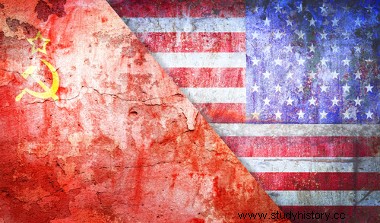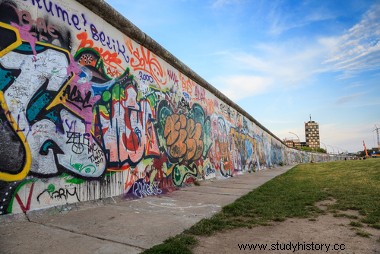
By Me. Cláudio Fernandes
To understand the period that became known as the Cold War , a period that goes from 1945 to 1989, it is necessary, initially, to know some facts that unfolded soon after the end of the World War II, in 1945.
It is well known that, even before the Second World War broke out, in 1939, there were already strong ideological positions throughout Europe and in various regions of the world. These ideologies consisted, mainly, of exacerbated nationalisms with an authoritarian bias, such as fascism and Nazism, and Stalinist communism, also with an authoritarian bias, both of which had the characteristic of being collectivists - that is, interested, above all, the social collectivity. , to the detriment of individualism, which was a hallmark of classical liberalism in the 19th century (another ideology that still prevailed in this period, especially in England and the United States).
What was polarization:Capitalism X Socialism?
To defeat the advance of Nazism, the countries that represented the liberal political tradition (USA and England, above all) united, momentarily, with Soviet communism, although the ideological positions on both sides were radically opposed. At the end of the Second World War, these ideological fronts began to delimit (geographical) “zones” of influence in various regions of the world. The Soviet Union, then led by Josef Stalin, whose central power was in Moscow, commanded the so-called “socialist bloc ”, which dominated all of Eastern Europe, part of Asia and, from 1959 onwards, exerted influence in Central America, through Cuba, which underwent a communist-oriented revolutionary process under the leadership of Fidel Castro. The United States, in turn, led the so-called “capitalist bloc ”, which became hegemonic in Western Europe (especially through the reconstruction plans of the war-torn countries), in the American Continent and in Japan – since China, in the Far East, had also gone through a revolutionary process and became communist in the late 1940s.
However, despite the reality of this opposition, it is necessary to make some reservations about the denominations “capitalist” and “socialist” (or communist). These words can indicate differences between perspectives on economic systems and political conceptions.
In the first case, the capitalist system is considered the advanced and systematic form of the market economy , which is guided by the valorization of private property, by free individual initiative, by economic exchanges with a minimum of state intervention, by price taxation determined by the market itself and by several other factors inherent to the market. The socialist system , from an economic point of view, views economic production from the Marxist understanding of surplus value and theexploitation theory .
In the communist critique directed at liberal theorists and defenders of the market economy, workers would be exploited by capitalist bosses through the sale of their labor power in the production relationship. It was necessary, therefore, that the foundations of the capitalist system be radically transformed so that inequality between classes disappears – private property and the free market, guided by entrepreneurship, would be obstacles to this egalitarian perspective of communism. The communist revolution (carried out in Russia by Lenin and the Bolsheviks) would “accelerate” the institution of this perspective.
The great criticism that liberal economists make of the socialist economic concept is to emphasize the impossibility of an economic system without a market, given that, in order to try to institute an egalitarian economic system, it is It is necessary for the state to control and plan the entire economy and, for that, it must control and restrict individual freedoms as well, harming the democratic political system.
The polarization of the Cold War, then, was marked by these two complex conceptions. Not to mention the presence of various mixtures of economic concepts such as the “Welfare State”, “social democracy”, the “labor left”, among others that mixed ideas of economic freedom and socialist egalitarianism.
Divided Germany, Berlin and the Wall as a symbol of the Cold War.
Germany, for having been the center, during World War II, of the enemy that became common both to Western powers, guided by liberal and capitalist ideology, and to the communist Soviet Union – that is, Nazism – suffered a major political crisis (in addition to the economic one) from 1945 onwards. After the war, the USA, France, England and the USSR divided the German territory between them, thus seeking to establish their respective zones of influence. . Two German states were then created, one western – ally of the “capitalist bloc” – and the other eastern – ally of the “socialist/Soviet bloc”.
The capital, Berlin, was on the eastern communist side. However, it was also divided due to the dispute over ideological influence. The western side of Berlin, from 1961 onwards, was completely surrounded by a three-meter high wall, made of concrete and barbed wire, built by the communists. This wall began to prevent the inhabitants of Berlin, both on the west and east sides, from being able to move freely through both territories. Along the 45 kilometers of the wall, guardhouses were set up with armed soldiers who constantly watched the siege. Undoubtedly, the Berlin Wall was the greatest symbol of the Cold War. And it only lost its function in 1989.

The Berlin Wall became the greatest symbol of the Cold War. Its “fall” in 1989 marks the end of this period
Other Cold War Features
The creation of the UN (Organization of United Nations), in 1945, is also one of the central events of the Cold War. The UN was created from the former League of Nations. As a globalist entity with varied objectives, among them, “guaranteeing peace” between nations and promoting policies of a humanitarian nature, the UN has relevant importance to this day. Its Declaration of the Rights of Man and of the Citizen, promulgated in 1948, influenced constitutions around the world throughout the 20th century. The UN's role in the Cold War was more intense and full of counterparts. The USSR, for example, was part of it at the beginning, but was later removed.
Other important facts were the creation of the State of Israel in 1948 – which provoked a wave of wars with neighboring countries, such as Egypt and Lebanon, in the following years –, coups d'état in Latin America, including Brazil, and local wars, especially in Asia and Africa. In this last point, the wars for the decolonization of countries, both in Africa and Asia, stand out. In addition, the dispute over zones of influence also demanded other local wars. The most famous are the Vietnam War and the Korean War.
The espionage, infiltration, subversion and disinformation techniques of the Soviet Union's intelligence agencies, the KGB, and the United States, the CIA, also played a significant role during the Cold War. Persecution of communists in the US and Latin America, as well as the defection of KGB members and their flight to Western countries were very common in this period.
In addition to these events, others, such as the so-called “Space Race ” and “Arms Race ”. Soviet astronaut Yuri Gagarin was the first human being to go into space in the year 1961. In 1969, American astronauts managed to go to the Moon, step on it for the first time, install scientific equipment and extract samples for analysis. The achievements of both sides of the ideological polarization of the Cold War were motivated by the rivalry that incited technological overcoming and the conquest of space, especially Earth orbit. In the same way, the geopolitical control of the zones of influence gave rise to a progressive development of military technology. The “arms race” is part of this context, especially with regard to nuclear weapons.
In the cultural field, the phenomenon known as counterculture became notorious. Examples such as the beat literature in the 1950s, hippie movement, rock 'n roll, popular protest music, protest theater, as well as new cinema manifestations, such as the Brazilian Cinema Novo, the Nouvelle Vague (Nova Vaga, Nova Onda) French, Italian Neo Realism, among others. The sexual revolution and the strength of the student movement also became evident at this time. The events of the month of May 1968 in Paris , set the tone for it.
Furthermore, the Cold War period only ended with the collapse of the Soviet Union in the 1980s, mainly due to the failure of state economic planning. Figures such as Ronald Reagan (US President) and Mikhail Gorbachev, General Secretary of the Soviet Communist Party, were decisive in bringing the Cold War to an end.
Take the opportunity to check out our video lesson related to the subject:
